As we change of the week, we also change of the government, and, rather excitingly, this year is a hundred years since the first ever Labour win.
This week has been another hectic one, so this preamble is short. Though I may return, if time, once the rest is done. However this is another newsletter with some very interesting cards and subjects, and I have enjoyed writing it. And it encompasses a Coin, a Champion, a Capital, a Conflagration, a Cowboy, a Car, and a Combat.
Lets start with ....
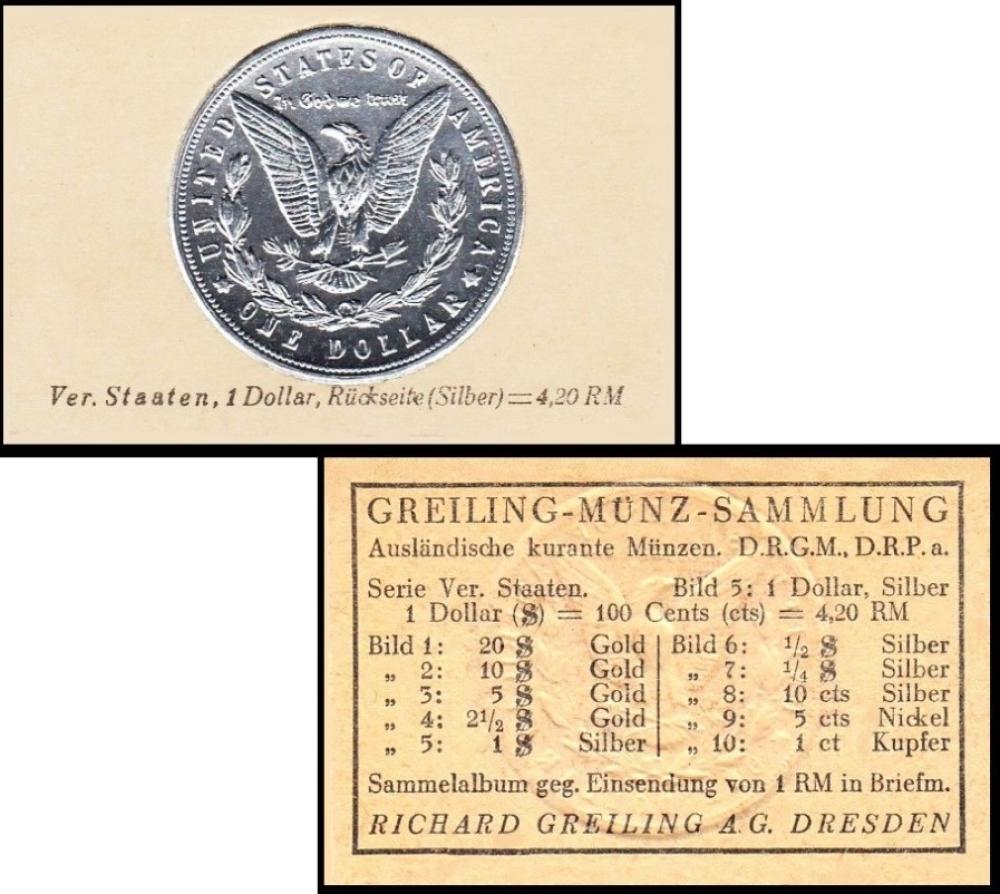
Zigarettenfabrik Greiling A.G. [tobacco : O/S - Germany - Dresden] "Greiling-Munz-Sammlung" (1929) Un/641 - G800-250.C.a : G74-14.C : X24/42
So lets start with the coin, the dollar, which, today in 1785, was authorised by the Continental Congress of the United States as a brand new currency. However it does not appear that any were produced as coins until 1792, when The Coinage Act established it firmly as the basic currency, and also created a new body called the United States Mint, which was to produce all the coinage for the country, and to circulate it, securely.
Strangely the Mint was not part of the Treasury - until 1873. Before that, it was run by the Department of State, though perhaps this was because of the value of the metals that made the coinage, in silver and in gold, and that these were also bought in, and stored, as pure gold and silver, being melted into currency when needed. It may also have something to do with the fact that it was not until 1853 that the weights of some of these coins were reduced, by adding other metals into the mixture.
Today very few gold coins are made, and they are almost never used as day to day currency, they are hidden away in banks and safe deposits as investments, their shine slowly dimming without even their owners noticing.
This is a truly amazing set, and yes there are almost six hundred and fifty cards. Not just that, but there are three main versions, described in our original World Tobacco Issues Index as :
GREILING-MUNZ-SAMMLUNG. AUSLANDISCHE KURANTE MUNZEN (Greiling`s Money, Current Coins of Foreign Countries). Size 107 x 42 with coupon, when cut about 62 x 42. Coins embossed. Nd. in sub series - see X24/42. (641). Three main backs. ... G74-14
A. Sub-series numbered in Arabic numerals. 32 sub-series.
B. Sub-series numbered in Roman numerals. 32 sub-series. 4 back formats.
C. Sub-series unnumbered. 65 sub-series.
Now that X24 reference is in the handbook to this volume, and the write up covers almost two pages. Not time to tap that in, so I will add it to the scanning list. It also explains the sub-series a lot better than the above.
This text is primarily the same in our updated World Tobacco Issues Index, except for our section C, which adds, after the above wording "Frameline on back (a) single (b) double".
The back of our card mentions the album, which you had to send for, at the cost of one RM, or ReichsMark. And the card also tells us that the current exchange rate of one dollar was 4.2 RM.
Now after a bit of a hunt I found that you can see an album, or a few pages of one, anyway, because one was sold in America, and is currently shown online at Bonhams Skinner`s Auction/GMS - however I am not sure how long this will be there, so if someone finds it gone in the future just tell us. This album reveals something else too, that the cards are in two formats, as a single large coin, which is either a front or a back, or as two smaller coins that show both a front and back on the same side and card.
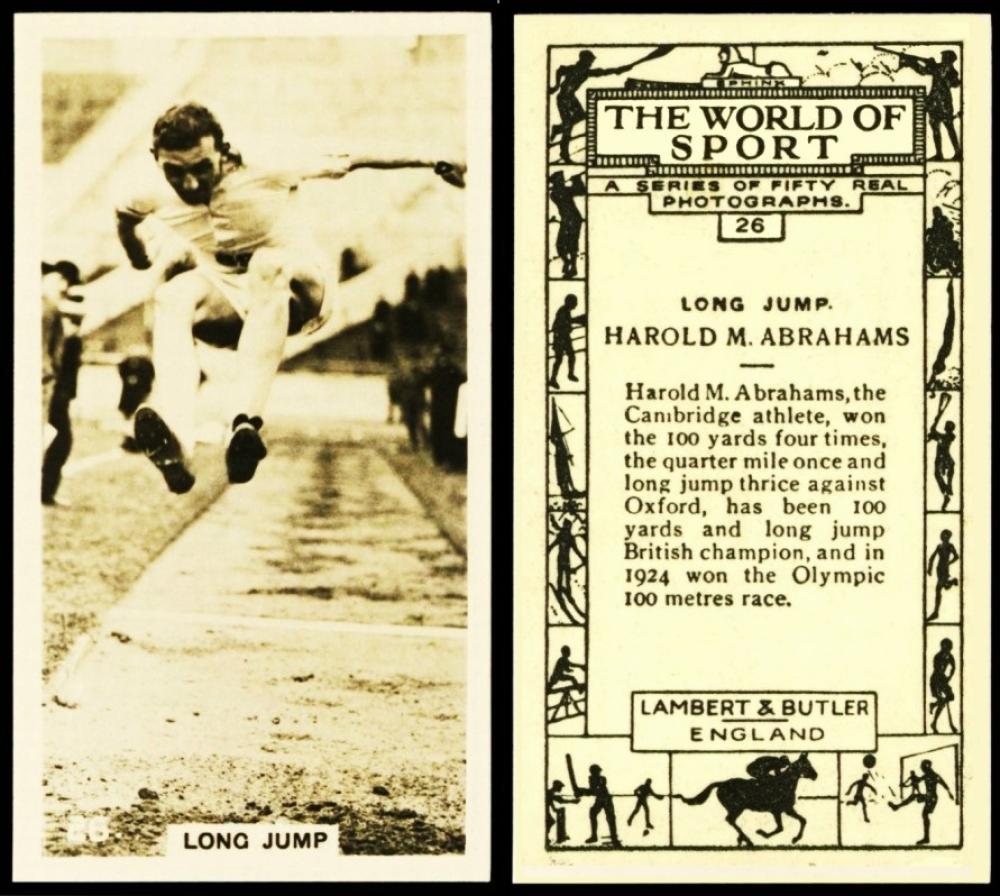
Lambert & Butler [tobacco : UK - London] "The World of Sport" (1926) 26/50 - L073-840 : L8-99 : RB.21/209-101.B : L/101 [RB.9/101]
Our first Centenary Card celebrates Harold Maurice Abrahams CBE, showing here, and it even mentions our reason for his inclusion on the reverse of the card, saying that "in 1924 [he] won the Olympic 100 metres race".
He was born on December the 15th, 1899, in Bedford, though his family were far from their original home, his father`s roots being in Polish Lithuania and his mother`s in Wales. There were three children in all, and all three ended up connected with sport; one brother, Adolphe, being a leader in the field of sports medicine, and another, Sidney, being a long jumper. Our man is also shown here as a long jumper, a sport he enjoyed, even before he went to Cambridge University. And it was that sport which ended his athletic career in May 1925, when he broke his leg in the course of a jump.
The Paris Olympics were his shining glory, though he did not compete in the long jump at all, he chose his other joy, running. And he won not only the gold medal at the hundred metres, which we celebrate today, but also a silver medal for the team 4 x 100 metres relay.
You can read more about his life, and sporting prowess at IJSGF/Abrahams. It is indeed an amazing story, and was deservedly made into a film biography, "Chariots of Fire", though the film is not entirely correct with some of its facts.
According to the Trading Card Database/Harold Abrahams he is featured on just eleven cards, starting in 1923. Several of these show him as a long jumper, and this, along with the fact that the front of our card says only "Long Jumper", leads me to believe that he may be on more cards, but not with his name in view, or maybe not at all. Also, look at Gallaher`s 1936 set of "Sporting Personalities", where he is neither long jumping nor running, but shown as a sports commentator.
This set is listed first in our Lambert and Butler reference book. RB.9, issued in 1948, as :
THE WORLD OF SPORT. Size 2 5/8" x 1 13/32" or 66 x 37 m/m. Fronts, uncoloured photo prints. Backs in black, with descriptions. Export issue, 1926.
It next appears in the original World Tobacco Issues Index, the text of which is identical in our updated volume, and reads :
THE WORLD OF SPORT. Sm. 66 x 37. Black and white photos. Nd. (50). See RB.21/209-101.B
Now that RB.21 takes us to the original British American Tobacco reference book, where we discover this text :
209-101. THE WORLD OF SPORT.
A. Anonymous issue, with letterpress on back.
B. Lambert & Butler, Overseas issue.
C. Machado issue.
Thanks to the index at the front of this book, we can add that the anonymous issue was issued in Malta in 1927. And also that B. & J. Machado Tobacco Co. Ltd, of Kingston, Jamaica, issued their version in the West Indies, in 1928.
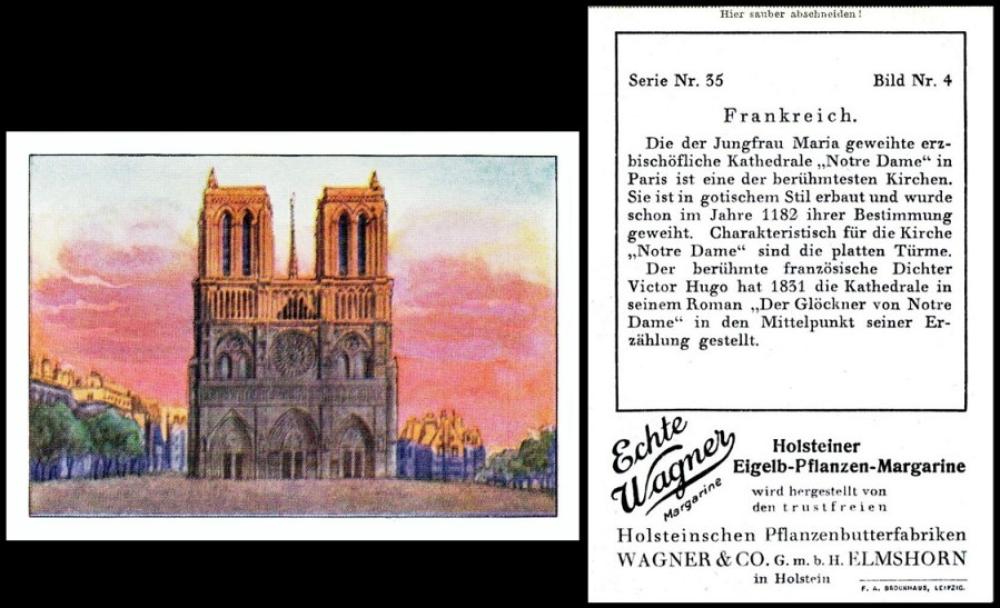
Echte Wagner [trade : margarine : O/S - Germany] "Eine Reise durch Frankreich" / "A Trip through France" (1929) Series 35, No. 4
We are going a lot further back than a Centenary now, for on this day what would become the city of Paris was founded.
We base this date on the celebrations that took place on July 8, 1951, which were to mark the two thousandth anniversary of the city. What we do not know is where they got this date from, because the first settlers in the area were the Parisii, who, around 250 B.C., found a way to colonise the island which is now known as the "Ile de la Cite" (or island of the city, after these origins). The next mention was in 52 B.C., when the area was under the control of the Romans, at which time it was renamed Lutetia - that also refers to its position, and means a place between the waters. Some time after that the name Lutetia was abandoned in favour of Paris, a contraction of and perhaps a tribute to the original inhabitants, or perhaps even a rebellion against its Romanisation. Then, in 987 A.D. Paris was being said to be the capital of France.
There are no buildings remaining from that date, but this is the Cathedral of Notre Dame, one of the earliest buildings in Paris, and also built on the Ile de Cite. However it did take almost a year to build, having seen the first stones laid in 1163, and it was not actually "almost completed" until 1260 - though it was not completely complete until some time after. Other French reasons for it being chosen for this space include the fact that Napoleon was crowned there, and that the celebrations for the liberation of Paris from Germany were also there, in 1944.
Echte Wagner is a name I have featured before, I like their "plant-margarine", and also their cards are spectacularly moody, look at this one, all mauves and blacks. Quasimodo, the Hunchback of Notre Dame, would have so loved this view.
The set, from this card, might seem to be views of France, and even when you read the full title, you may still consider it a tour of the country. However it is not, it is a mini tour back through time, and as there are only six cards I can list them.
- President of the French Republic, Gaston Doumergue
- A map of France
- The Eiffel Tower 1889
- Notre Dame
- The First World War
- French currency
Now one thing that look unfamiliar to me from when I have shown this maker`s sets before, is that right at the top there is a dotted line, below which are the words "Hier sauber abschneiden", which basically means "cut here". This means that the cards must have been issued in strips or sheets. So can anyone tell us more about this
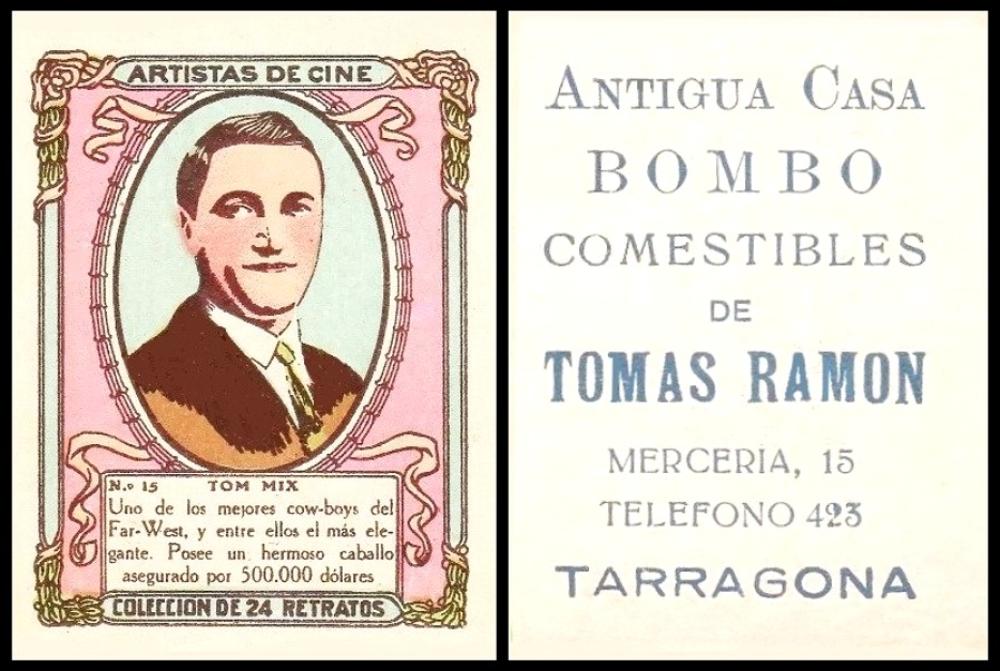
Tomas Ramon [trade : food? : O/S - Spain] "Artistas de Cine" / "Cinema Stars" (1920s) 15/??
This card tells a sad tale, for today in 1937 saw a cinematically-tragic fire break out at the Fox Vaults in Little Ferry, New Jersey, killing one person, injuring two others, and destroying many masterpieces of the silent film era. And this man, Tom Mix, had eighty five of his films lost, almost a third of his movies, gone forever.
The reason for the fire was a combination of human error, and a sudden heatwave, though some explain it as that the studios did not know of how they needed to store the early nitrate films that they were saving.
The human error was the simplest, ventilation, for when the film decomposed, it produced flammable gases, and these had nowhere to go except to explode. The heatwave merely warmed the film and made more gases. However the problem with the flammability of film was well known, and had been so for many years. In fact the first film fire was in Paris, on May the 4th, 1897, a projector was seen to smoke and then catch fire. This resulted in a hundred and twenty-six deaths. Closer to home, there had been vault fires at Lubin and Edison, both in 1914, and the Edison complex was not only in New Jersey, but was just six miles away from the Fox vaults.
However there may have been one big reason why Fox seem so complacent as to the risks. This was because the film storage vaults were not just converted areas, they had been specially, and specifically built, just three years earlier, with thick brick walls and a strong concrete roof, plus with steel doors to each one of the separate vaults. The reason for this extra effort was to provide fireproofing, but crucially, it was against fire coming in from the outside, not starting within the building. And with that in mind there were no water sprinklers, and no ventilation, for any opening to the outside world was thought to be a way let any fire in.
This is an unusual set, and it is seldom seen in the British Isles. We know almost nothing of Tomas Ramon, only what is on the reverse of the card - "Antigua Casa, Bombo, Comestibles, de Tomas Ramon, Merceria, 15, Telefono 423, Tarragona".
Now I have just been told that there is an album for these cards, and that tells us that the collection is complete in twenty-four "retratos" - or portraits. The album does give us a few more clues about the issuer too, that he distributes through "Antiguas Tiendas" (old shops) and "ultramarinos" (restaurants) and is based at the Old Casa Bombo, at Merceria 15. Now in Spanish "bombo" means a drum, so this seems to be an old military building, with Merceria, 15 being the address.
This address still there, but it is now a handicrafts shop.
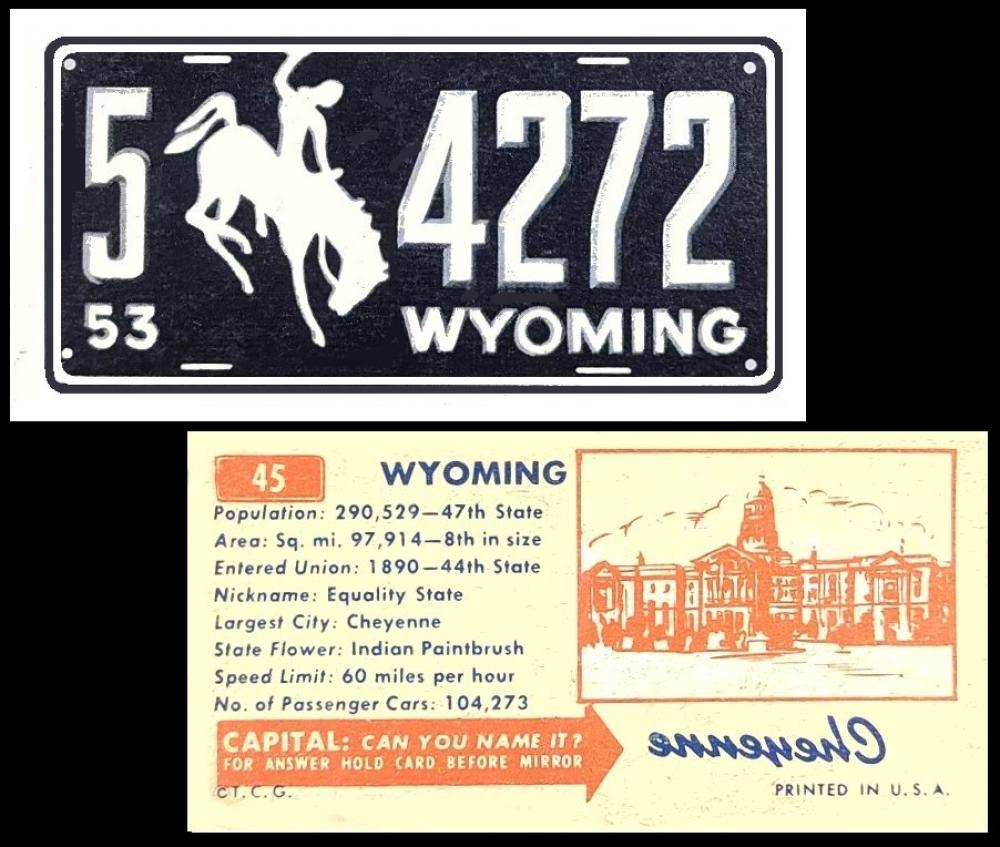
Topps [trade ; bubble gum : O/S - USA ] "License Puzzle Plates" (1953) 45/75
Today in 1890, Wyoming became the forty-fourth state of the United States of America. Its earliest appearance on cards, though, both come in 1888, which pre-dates that. These cards are Allen & Ginter`s "Flags of States & Territories" and Duke`s "State Governors".
It is a pretty big county to have taken so long to join, and also it is bordered by six others, all but one of which was already part of the United States by then Nebraska (1867 - 37th), Colorado (1876 - 38th) South Dakota (1889 - 40th), Montana (1889 - 41st), and Idaho (1890 - 43rd). Only Utah held out on joining for longer, taking until 1896 to become the 45th State.
I have to say that if I picked my residence by the number plate this would be my top choice, the cowboy, and the horse, and especially the modern plates, which have a coloured, real photo landscape of the Green River Lakes.
Now many cartophilists will have noticed that this set is very similar to ones that were issued in 1937 and 1938/9 by The Goudey Gum Co. of Boston, Massachusetts. The backs of those even have facts about the State, but in a different style to ours.
However, if the Goudey set had been issued earlier, this resemblance may not have been noticed, for it would not have had the cowboy and horse logo on it - that was only introduced in 1936. Another thing you may not realise is that the 1937 and 1938 plates they feature on their Wyoming cards may look black and white, but they were actually a very dark brown and white - black and white plates being first introduced in 1943.
And, curiously, the latest plate, not yet finalised, is predicted to return to the black and white design on this card, with a buffalo behind it.
Now these cards are more usually known as License Plates but if you look at an original packet it calls them "License Puzzle Plates" obviously referring to the question and backwards answer on the reverse. And that packet also gives us the retail price of 5 cents.
You can see most of the cards at The Trading Card Database / Topps53, and many of the backs are there too, if you want to have a go at the puzzles.

Abdulla [tobacco : O/S - Berlin] "Abdulla-Autobilder" / "Abdulla`s Motor Cars" Serie I (1931) 72/150 : A065-010.1 : A5-1.1
Nearing the end of our week now, so here is a little treat for everyone who ever drove a Fiat motor car - though I doubt few of us ever drove one like this. Anyway, today, in 1899, Fiat was founded by Giovanni Agnelli and several backers/investors - and, you may be surprised to learn that the actual name was not Fiat at all, it was the Fabbrica Italiana Automobili Torino, or, in English, the Italian Automobile Makers/Factory of Turin. It is only when you reduce those Italian words to initials that you get F.I.A.T. This was changed to "Fiat", with less capital letters, and no full stops in between, in 1906.
Their first "car" was hardly a car at all though, it was, to all intents and purposes, an open carriage with a canvas hood at the back, though the shafts for the horse had gone, and the reins had been replaced by a steering wheel. However the company moved on very quickly - making its first works vehicle, a truck, in 1903, and its first aeroplane engine in 1908. In that same year they had their first overseas buyer, from America - something which almost certainly sped up their decision to open a factory in New York, which opened in 1910.
This card was issued in Germany, by the German section of the Abdulla company, which issued cards out there between 1928 and 1933. It did not issue more cards after that, because it was liquidated the following year. There is almost certainly a story there.
I thought this set would be in our Cartophilic reference book Np.5, issued in 1943, which covers the issues of Abdulla, along with Adkin and Anstie. Sadly it is not, for that booklet only has the English language issues in it, which means that this set`s first appearance is in our original World Tobacco Issues Index, with the other German Language Issues as section one of the Abdulla listings. And the entry there reads :
ABDULLA AUTO-BILDER (Abdulla`s Motor Cars). Md. 75 x 49. Nd.
1. "Serie I". (150)
2. "Serie II". (150)
It is virtually the same in our updated version but the 1 and 2 descriptions are on the same line, to save space.
Now we have been told of a few other things that are not here. There was an album, for one thing, on which the title was "Autobilder (Automobile der bekanntesten Marken des In- und Auslandes) - aus der Reihe" - and that translates to "Automobile Pictures (The best known automobile marques, at home and abroad) - all lined up [or perhaps "on display"].
There is also a strange thing with series II in that the set is listed as being of 150, but two of those cards, 28 and 29, were replaced later. Now since this newsletter was originally compiled, one of our readers, and contributors, Stuart Arnold, has written in to say that the cards which were changed were actually illustrated, both sides, on his website. He thinks that what happened was that a newer model came along and so the card was changed to show that instead.
Curiously these cards are both from the Stoewer factory, which was originally founded in 1896, near the Polish border, to produce sewing machines. Just three years later the brothers founded Gebruder Stoewer, Fabrik fur Motorfahrzeugen, a car manufacturer. This set was issued at the time that they developed one of the first ever front wheel drive cars, and you might think that worthy of inclusion on it, or maybe the reason for the change, but it was not.
It is recorded that in 1936 the company started to branch out into four wheel drive, and started making cars for the German Army. However, in 1935, their town of Stettin had become, almost overnight, the headquarters for many military units - so it seems to be more the case that the decision to do this was not entirely theirs. Within a year Bernhard Stoewer, the younger brother, was dead, in his early sixties, but at least he did not see his factory taken over entirely by the Germans and forced labour being introduced. The older brother, Emil, lived until 1942, and I think it better to not investigate how he died. Then, after the Second World War was over, the Russians took control, and relocated all the contents of the factory back home, closing it forever.
Mr. Arnold also corrects my error with the title, it ought to read "Autobilder (Automobile der bekanntesten Marken des Jn- und Auslandes) - aus der Reihe" whereas I had written "In". Curiously he also tells me that the letters "I" and "J" were often used interchangeably. I also found out that in Germany, these letters are also pronounced as an "I", however when the next letter is a vowel they use the "J" in the spelling instead of an "I".
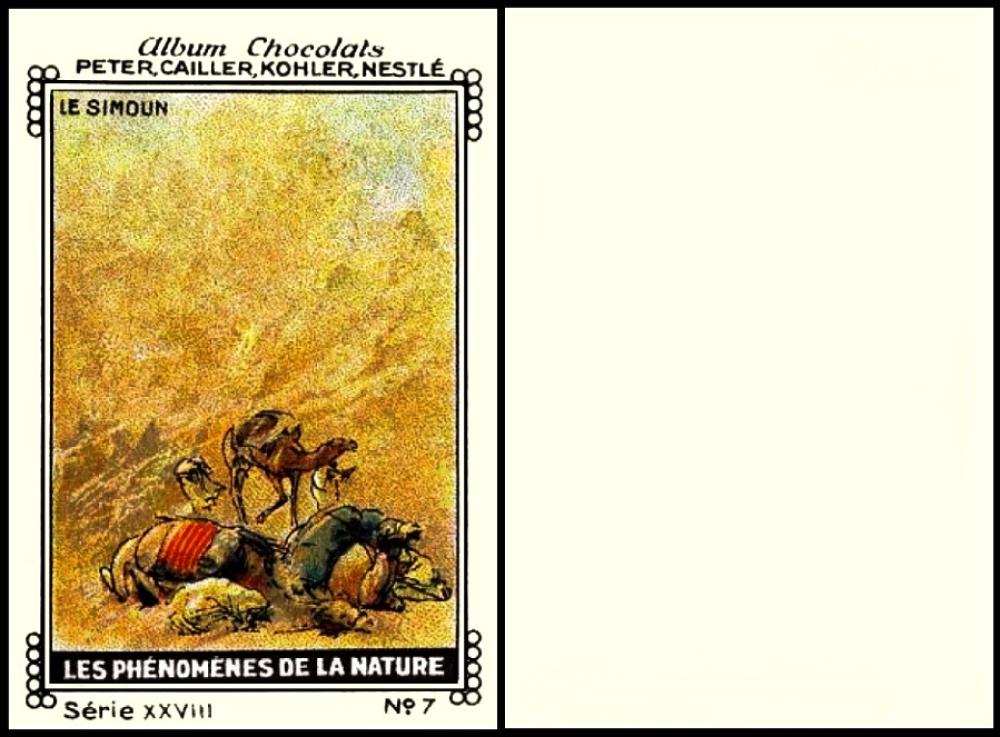
Peter, Cailler, Kohler, Nestle [trade : chocolate : O/S] "Les Phenomenes de la Nature" / "Natural Phenomenon" (1920s?) Series 18, card No. 7
Today is the International Day of Combating Sand and Dust Storms - and this is almost a brand new day, it only started last year, through a webinar for members of the UArctic Thematic Network on High Latitude Dust.
We used to associate dust storms with heat and flat deserts, as is shown so effectively on our card, and also on card 35 of Ogden`s set "The Story of Sand" (issued in 1935), where three camels race through the swirling air and the trees of the oasis are bent into twisted shapes by the force of the accompanying wind.
These days, though, almost certainly thanks to global warming, it is also being recorded in the cold, and at height, and at places it has not been troubling before. This will almost certainly lead to a decline in human health, through the dust entering the lungs in the normal, and unstoppable act of breathing, and whilst that mainly affects those with already weakened lungs, because of asthma, or chronic obstructive pulmonary disorder, it also leads to coughing, which can trigger many other reactions. And, more than that, the wind whips up all manner of substances in that dust which can cause allergic reactions. A sufferer may be careful of what they eat, or handle, but they cannot guard against what they do not know is in the air.
This card was sent in by Mr. Small, who contacted me to say he had several cards from the set I featured in last week`s newsletter (the card for Friday the 28th of June), but the numbers were not in the same order. After some scans were examined, his turned out to be the same title, but not by Meurisse, his were these, and some of the cards were also different. So the full list of these ones, translated into English, is :
- 1. Geyser
- 2. Volcanic Eruption
- 3. Lightning
- 4. Cyclone
- 5. Rainbow
- 6. Avalanche
- 7. Sandstorm
- 8. Earthquake
- 9. Waterspout
- 10. Storm (at sea)
- 11. Fog
- 12. Aurora Borealis
Now I have also discovered that this set was reissued at a later date, the front is almost exactly the same, but the base wording differs. Whereas ours says "Serie XXIV" to the far left, and "No. 7" to the far right, the reprint says "Serie 28" to the far left, adds a "B" in the centre, and repeats the "No. 7" at the far right. I do not yet know when the cards were reissued though.
This week's Cards of the Day...
were, for the most part, supplied by a reader, who also gave me a lot of the information I used for the text - and also allowed me to share some of his amazing cards with you all.
The theme revolved around the formation of the N.B.A. - or National Basketball Association, on August 3rd, 1949. Now you may be shaking your head at this - for it is only just July - but bear with me. For whilst it was on that date that the newer B.A.A. - or "Basketball Association of America" - merged with the older N.B.L. - or "National Basketball League", it was later decided to not write off the story of the sport, but to consider the founding date of the older group as their own. And the Basketball Association of America had been founded on June 6, 1946. That too was a merger, of two professional leagues; The American Basketball League (started in 1925) and the National Basketball League (founded in 1937).
However, and intriguingly, the sport of basketball was invented much further back, in 1891, and in Springfield, Massachusetts, by a Canadian, a P.E. teacher called James Naismith. Why he invented it was to provide exercise for athletes in the Winter, and, then, also between their training routines at other times, for it was both strenuous and exciting, as well as not being too hazardous to their health as a game like football may have been.
Mr. Naismith has another sporting claim to fame too, which you can read about in our newsletter for the 4th of November, 2023 - just scroll down to Monday the 6th of November.
So our first clue card to this theme was ...
Saturday, 29th June 2024
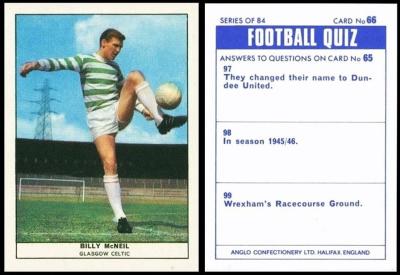
This first clue here was a bit obscure, but it was the clothing, for one of the nicknames of the Celtic Football Club is "The Hoops", and that concerns their green and white jersey. In fact at first they played in an all white strip, but then, in 1903, they changed to a green and white one, which might be considered to be striped, but is technically considered to be hooped. I believe that this comes from the fact that a stripe is straight, whilst a hoop curves at the edges to make a continuous circle, as it does around the body.
Here we have William "Billy" McNeill MBE, born on the second of March 1940. He was the obvious choice for a card for Celtic, as he had so much connection with them, over sixty years during which he was a player, a captain, a manager, and a coach - as well as being at the helm when the team won the European Cup in 1967. It is most fitting that he continues to lift that cup as a statue outside their stadium, though perhaps it is a belated apology for the way he felt he was so underappreciated by the team in the 1980s.
This set appears first in our British Trade Index part III, as :
Football Quiz. 76 x 56. Nd. (84) ... ANF-13
And its not much different in our updated British Trade Index, except that the date of issue has been added before the measurements, and there is a new card code.
I can, however, give you some useful links, courtesy of Nigel`s WebSpace; a Set gallery of all the cards - plus a Set checklist and a Team checklist.
We also know, thanks to the Trading Card Database/AFQ that these were issued with bubble gum, and the brand, "Bubbly" - also that the packets were retailed at 3d. each. This brand was introduced in 1932, and it is a single thick piece of pink bubblegum inside a wrapper, curled round and twisted to the left and right of the piece. Today we also appreciate that it is made with natural colours and flavours.
As to why it was pink, well that was the only food dye the factory had in stock at the time. Just a lucky coincidence.
Another interesting fact is that the "Bubbly" brand is now owned by Barratt - so if you order them online you need to look for Barratt Anglo Bubbly.
Sunday, 30th June 2024

The easy clue here was the fact that these are Cannon "Balls", rather than Basket Balls. Or you may also have picked up on the word "Shot" because this is, simply, the action of throwing the ball towards the hoop. However there is a harder one, because there is a video game called "Cannonball Basketball". Do we have any players of that amongst our readers? I am not great at such things, because they all go too fast for me, even at the very basic level, and I get most confused. However I might have a go, via the link provided. Feel free to do that as well, if you like, on a rainy day.
Lots of confusion with this card too. Firstly, look at the back and you will see says "Series B", yet look in a catalogue and there is not a "Series A" of this title. Then the cards themselves, when you read about them, are described as being Past and Present, showing an example of an item from the past, paired with one from the present day. However this leads you to believe that the pictures are split, showing both old and new at once, and that is not the case.
The matter of the series lettering does becomes clear when you read the listing in our original World Tobacco Issues Index, which says :
PAST & PRESENT. Sm. 68 x 34. Nd. ... T18-21
1. Series "A" - The Army. (24). Back in blue
2. Series "B" - Weapons of War" Nd. 25/48. (24). Back in black.
3. Series "C" - Transport. Inscribed "Nos. 49-100". Nos. 55/58 only issued. See C.N.N. Vol. 11, page 60. Remainder of subjects reprinted and issued in anonymous printing, see Set ZA8-34.
However you have to acquire a set, or several cards, before the truth about the Past and Present reveals itself, for what actually happens is that cards one and two, and so forth, show first the old, on one card, and then the new, on another. For example, card one is a "Stone-throwing Machine" used by the ancient Greeks and Romans, and card two "Naval Artillery". Our card, number thirty-nine, is a variety of cannon balls, and is accompanied by card forty, of a modern Artillery shell. Which I will add some time.
Now in our updated World Tobacco Issues Index there is more information, namely :
PAST & PRESENT. Sm. 68 x 34. Nd. ... T200-860
1. Series "A" - The Army. (24). Back in blue, (a) with (b) without framelines
2. Series "B" - Weapons of War" Nd. 25/48. (24). Back in black.
3. Series "C" - Transport. Inscribed "Nos. 49-100". Nos. 55/58 only regularly issued. Remainder of subjects do exist, but were also reprinted and issued in an anonymous printing, see H.645.
I do note that with this one listing there are two items here that are still missing from our gallery - "The Army" and the four cards of the Teofani printing of "Transport".
Monday, 1st July 2024
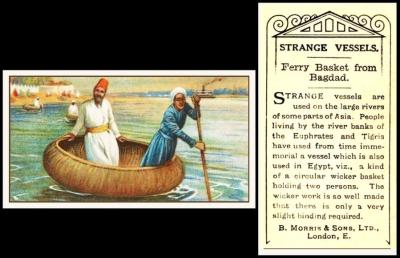
Now the clue here was pretty obvious if you knew the other two, but it was the item that these two men are crossing the water in, and that is a Basket.
The card tells us that this "circular wicker basket holding two persons" is used along the banks of the Euphrates and Tigris, as well as in Egypt, presumably on the Nile. On the Euphrates it is known as a Kuphar, with regional variations, and, on the Tigris, as a Kufa. And they are still used to this day.
Some collectors count this as but part of a larger set, that they call "General Interest", though that name does not appear on the cards at all, whilst other collectors think each set of six cards is separate, and titled in the way that it does appear on the cards. Sadly we will never know the truth as to this, they are way too old to appear in any new issues reports in cartophilic magazines, and there never was a reference book on the works of B. Morris.
The cards are listed in our original World Tobacco Issues Index, but in a way to please both camps, as :
GENERAL INTEREST SERIES (A) Sm. 67 x 37. Unnd. Series of 30, in 5 sub-series. See H.280. ... M142-11
1. "Agriculture in the Orient" (6)
2. "Architectural Monuments" (6)
3. "The Ice Breaker" (6)
4. "Schools in Foreign Countries" (6)
5. "Strange Vessels" (6)
The titles in bold are links, but note that the "Architectural Monuments is a newsletter link, so you must scroll down - to Thursday 8 December 2022.
H.280, by the way, is a Handbook code, and it lists the cards in each set - so I will add that to the ever growing scanning list.
This text is identical in our updated version, but the "M" code has changed.
Tuesday, 2nd July 2024
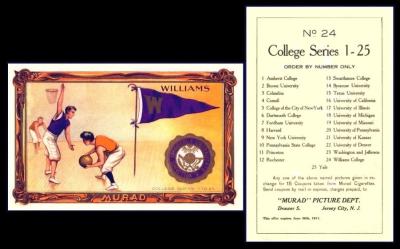
And now on to the cards of our basketball collector, starting with one of the most sought after basketball cards of them all, for many reasons, but primarily because it was one of the first four cards to ever show a team, playing the sport. That team is from Williams College in Massachusetts, which was created as a college for men only in 1793, through a bequest from the estate of Ephraim Williams, of that state, who was killed at war in 1755.
It is also the only basketball card in this first subset of twenty-five cards, the three others coming from later ones, Northwestern in the second group, Luther in the fifth and Xavier in the sixth. The final two also only show a single player, and not a match in progress.
Actually North Western is a more interesting card, for it shows six men from two teams, one having an orange strip and one a dark one, and there is also an official holding the ball. Looking at the flag, which is dark mauve, we can safely say that these darker clothes are the same colour. It is suspected that the other team is from Syracuse, who have taken the gender-friendly step of becoming Syracuse Orange, and we know that the two met only twice in the years that this card was issued, on the 13th of February 1909, and on the 23rd of February 1910, and that Williams lost, both these times.
As far as the card chat, the first thing to note is that "Murad", the only name shown on this card, is not the issuer, though if you look up "Murad" in our original and updated World Tobacco Issues Indexes you will find a note to check under American Tobacco Co. - Group Issues. The cataloguing there is for the entire set of 150 cards, and it reads :
COLLEGE SERIES. Md. 68 x 52. Bkld. (150). Inscribed "S. Anargyros" and "Murad". Ref USA/T.51
1. "College Series 1-25" (A) unnumbered (B) numbered on front (C) inscribed "Second Edition"
2. "College Series 26-50" (A) unnumbered (B) inscribed "Second Edition"
3. "College Series 51-75"
4. "College Series 76-100"
5. "College Series 101-125"
6. "College Series 126--150"
Now that T.51 reference is the American Card Catalogue by Jefferson Burdick, and he lists these cards as :
T.51. College Series. (150) Murad.
Six series of 25 each. First two series in a Second Edition, with minor changes. A few unfinished errors without printing known.
He values them at just 0.5 cents each. This is very different from their value today.
By the way most of those "unfinished errors" seem to be missing colours, and it is most noticeable on the pennant, which is a different colour to the norm, owing to one of the colours in the run being missing. What happened was that each large piece of card, with several cards on, had to run through the printing press more than once, and each time it did, a different colour was laid on top of the cards, making, eventually, a fully coloured card. However if there was a fault, the ink ran out, or was not liquid enough, the incomplete sheets would have gone on a pile to be discarded, and these were then sometimes removed, and later would find their way into circulation, where they would be snapped up as rarities, when really they were never intended to be seen.
In actual fact "Murad" branded cigarettes were hand rolled, and made of pure Turkish Tobacco. And they have quite a tale to tell, because "S. Anargyros" is not a brand, it is a person, a Greek, born in Spetses in 1849. He moved about, a lot, and from a very young age, all across the Mediterranean, to Turkey, where he first encountered Turkish cigarettes, and then into Europe, ending this leg of his journey in England, where he again met up with tobacco products. From there, he emigrated to New York, and found a job, in tobacco. He also found friendship, and perhaps a surrogate father, in the big boss of the works, and when this man died, our man found out he had been left the entire company. From there he built it up to become a huge enterprise, larger than anyone had ever thought possible. Then he fell in love, with his second cousin, who tries hard, but does not like America, or maybe misses her homeland, Greece. And so he sells up and goes back with her. Not only that, he prospers, pouring his money into the area, building a hotel, and returning a desolated forest to its former glory, and lastly, creating a school that is still educationally prominent across the world to this day.
Wednesday, 3rd July 2024
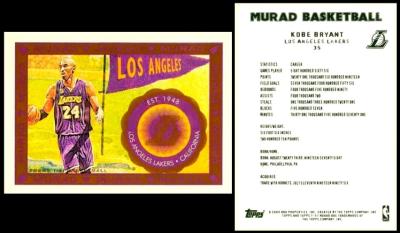
I wonder how many of us knew that that famous Murad "College Series" set which we featured yesterday was re-imagined by Topps? If not, here it is. It is heartening that they pay tribute to the original with the name, and even, quite wonderfully, by including Jefferson Burdick`s "T.51" code as part of the title.
However, I have to wonder how many modern collectors have ever taken the time to think for a moment on why that code is there, and what it represents, let alone to go off and look it up online. I did that though, and it is hard to find any mention of Jefferson Burdick, or the original set, most of it is about body armour used in "Fallout". Even looking T.51 up on Wikipedia only brings you to links concerning aviation, motoring, wheelchair racing and computing. It is only when you add the word "Murad" that the Topps set pops up, along with the original, if you scroll further down.
This card that has been chosen to represent the set for you is especially poignant, as it shows Kobe Bean Bryant, who played for the Los Angeles Lakers for the whole of his career, twenty years, and won Olympic gold medals in the team event. He also won an Academy Award - "Best Animated Short" for a lovely tribute film to the sport that he so loved.
Sadly, he was killed in 2020, along with several others, including his daughter, in a helicopter crash.
His father, Joseph Washington Bryant is still alive, and he was also a basketball player, for several teams, in America and in Europe, as well as a coach, in America, Europe, and Asia. He also appears on cards, though not quite so many as his son. You can see this for yourself at The Trading Card Database Joseph Bryant and Kobe Bryant
This set, like most modern sets, is not just a base set, there are lots of variety cards, which you can explore at the Trading Card Database/ToppsT.51. And, thrillingly, in another nod to cartophily of yore, these additional items include a heark back to the days when "cards" were actually leathers, and silks, and even grew to such a size that they were regarded as cabinet cards, which, in this case, are also linked back to the original "Murad" versions by a "T.6" code.
Thursday, 4th July 2024
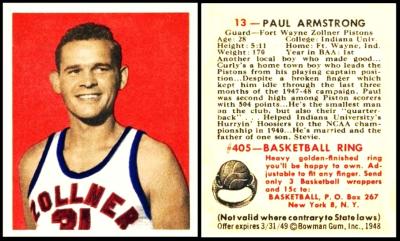
Now despite the early appearance of the first card that showed basketball, there was then a long time when it fell out of view. It only re-appeared in the early 1930s, as card eight of a set of thirty one "Sports" trade cards by The C.A. Briggs Co. of Cambridge, Massachusetts. Now these were issued with sweets, the curiously named "H.B." - and it gets even more curious because "H.B." actually stood for Hospital Brand, and referred to the part of their range which was cough drops and lozenges.
Each of these cards feature a different sport, with an artists representation of a person playing it. The one that everyone seems to want is the "Baseball" card, because it was modelled on "Babe" Ruth. The cards all have solid backgrounds, and show the sport in play. On the reverse is a split back, the top telling facts about the game (and mentioning the inventor, Mr. Naismith), whilst the bottom tells the collector that on completion of the set, it could be returned in exchange for either "a baseball, bat, or mit (sic), or 1 lb. Assorted Chocolates". It does not look like the cards were returned, which is why they are presumably scarce today.
After that there was another no show, until our set of the day was issued in 1948 by Bowman`s Gum. And this was a real turning point, because the whole set, all seventy-two cards, featured basketball. This was quite a big leap for Bowman`s, considering that the Basketball Association of America was only founded two years before.
Bowman does seem to have taken a bit of inspiration from the Briggs cards, with the same solid background, but their cards show actual stars of the game, not artist`s impressions. Another big claim to fame, though, is that the set, or the second series, anyway, includes George Lawrence Mikan Jr`s" Rookie" card (at number 69). And probably an even bigger fact than that is that it was the only set of basketball cards that Bowman`s issued (before they were sold to Topps).
However after this set was circulated, nobody picked up the ball, as it were, and it would be nearly another decade before basketball was again turned into a set of cards
Our man, Paul Armstrong, only appears on one other card, issued in 1950, which says "Bread For Health" in big letters at the bottom but does not actually give an issuer. However if you count reprints, you will find another card, for our set was reprinted in 1990. At which point we must say do be careful if you are buying any cards or sets of this original Bowman "Basketball", because the only mention of "1990 REPRINT" on those cards are the very small letters at the bottom of the reverses, pretty much always beneath the wording "(C) Bowman Gum"
Friday, 5th July 2024
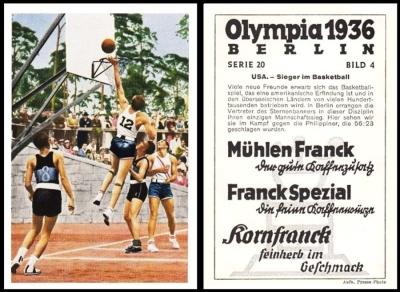
Here, to close out our week, we have a very unusual card, and maker.
Now a few people think that the name on the card, as we say it, is incorrect, and that it really stands for a Mr. Franck, who ground, or milled ("muhlen") the coffee that he sold.
I have had a very quick follow of that lead and this could well be the case, except that Mr. Franck seems to be Croatian, and, intriguingly, to be the first person that thought of turning chicory into a substitute for coffee. His company started in 1828 as Heinrich Franck Sohne G.m.b.H., and the website contains a pictorial archive. Only problem is that it does not mention a branch in Germany - but it does show an Austrian one, which opened in 1879. And it is quite possible that this is the one which issued these cards.
Now when the Olympic Games came to Berlin, several sets were issued, but these were mostly with tobacco products, it is scarcer to find trade cards.
Also this very card is important to our theme, because the 1936 Olympics was the first year that had basketball as a medal sport, though it had been a demonstration sport as early as 1904, in St. Louis, USA - and also at the London Olympics in 1924. All the players were men though - women did not compete in Olympic basketball until 1976.
The image on this card shows the American team, who took the record for the most number of points scored in a game, fifty-six, in their first round, against the Phillippines. In the final they faced off against Canada, winning 19-8. They were also cheered on by none other than James Naismith, who awarded the medals too.
We know who the man scoring the goal is as well - he is the captain, Joe Fortenberry, a keen college player, and sought after, because he was almost seven feet tall. Now he played for two teams immediately after leaving college, both of whom have pretty amazing names. First was the Ogden Boosters, out in Utah, and then the McPherson Oilers, in Kansas. This is where he was playing when he got the nod for the Olympics.
He got eight of those final Olympic medal winning points too, despite the game being almost called off due to quite appalling weather, and playing conditions, the rain causing the clay court to turn to a river of mud.
After the Olympics he returned to America, and played right up to America`s entry into the Second World War, at which point he joined up to the Army Air Corps. After the war he settled down, selling petrol. And he died in 1993, aged eighty-two.
And, as a parting shot, he is also said to be the first ever player to successfully "slam dunk" a ball more or less every time - some of the other claimants for that honour only getting theirs infrequently, by luck. For the non-basketball fans amongst our readers, this term means that you leap in the air and push the ball through the net with both your hands. But hopefully after this week you will be a bit of a basketball fan too, or at least a little more learned about its great past and thrilling future.
and as the clock chimes on the midnight hour I am all done.
It has rained pretty much all day today, which probably helped, as nobody wants to go out in that.
I also started early, and that is the real key to completing these newsletters, because if I get a fair enough proportion of it done over the weekend and first few days of the week, I do not have to panic quite so much on Friday night when I find there is no internet, or I have run out of battery as I worked beneath the cover of darkness. Also I was much assisted by my newly found basketball friend, who supplied all the game cards and a lot of the text as well.
But saying this I do really enjoy writing these newsletters, they take me to places I may never have discovered without, and I frequently find facts that amuse and astound me in pretty much equal measure. Coincidences too. The world out there is filled with those, and miracles too, if we have an open mind enough to allow them in. You should try it, as much as possible.
See you all next week!
